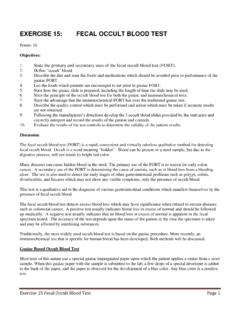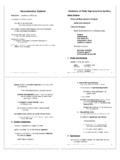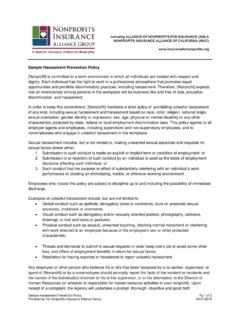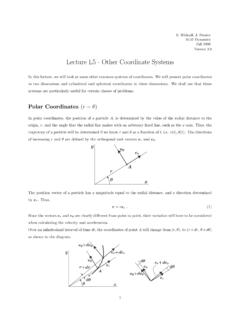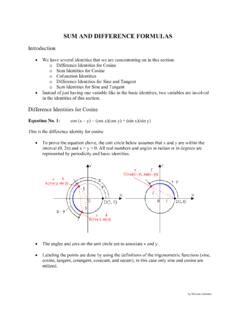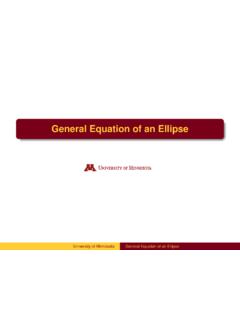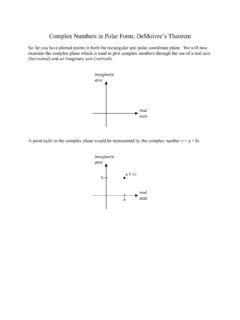Transcription of Chapter 15 Oscillations and Waves
1 Chapter 15 Oscillations and WavesMFMcGraw-PHY 2425 Chap 15Ha- Oscillations -Revised 10/13/20122 Oscillations and Waves Simple Harmonic Motion Energy in SHM Some Oscillating Systems Damped Oscillations Driven Oscillations ResonanceMFMcGraw-PHY 2425 Chap 15Ha- Oscillations -Revised 10/13/20123 Simple Harmonic MotionSimple harmonic motion (SHM) occurs when the restoring force (the force directed toward a stable equilibrium point) is proportional to the displacement from 2425 Chap 15Ha- Oscillations -Revised 10/13/20124 Characteristics of SHM Repetitive motion through a central equilibrium point. Symmetry of maximum displacement.
2 Period of each cycle is constant. Force causing the motion is directed toward the equilibrium point (minus sign). F directly proportional to the displacement from = - 2 x DisplacementMFMcGraw-PHY 2425 Chap 15Ha- Oscillations -Revised 10/13/20125A Simple Harmonic Oscillator (SHO)Frictionless surfaceThe restoring force is F = 2425 Chap 15Ha- Oscillations -Revised 10/13/20126 Frictionless surfaceTwo Springs with Different AmplitudesMFMcGraw-PHY 2425 Chap 15Ha- Oscillations -Revised 10/13/20127 SHO Period is Independent of the AmplitudeMFMcGraw-PHY 2425 Chap 15Ha- Oscillations -Revised 10/13/20128 The period of oscillation =Twhere is the angular frequency of the Oscillations , k is the spring constant and m is the mass of the The Period and the Angular FrequencyMFMcGraw-PHY 2425 Chap 15Ha- Oscillations -Revised 10/13/20129At the equilibrium point x = 0 so, a = 0 also.
3 When the stretch is a maximum, a will be a maximum velocity at the end points will be zero, and it is a maximum at the equilibrium Harmonic MotionMFMcGraw-PHY 2425 Chap 15Ha- Oscillations -Revised 10/13/201210 Representing Simple Harmonic Motion MFMcGraw-PHY 2425 Chap 15Ha- Oscillations -Revised 10/13/201211 Representing Simple Harmonic Motion MFMcGraw-PHY 2425 Chap 15Ha- Oscillations -Revised 10/13/201212 Representing Simple Harmonic Motion Position - xmax = AVelocity - vmax = AAcceleration - amax = 2A MFMcGraw-PHY 2425 Chap 15Ha- Oscillations -Revised 10/13/201213A simple harmonic oscillator can be described mathematically by.
4 ( )( )( )2x t = Acos tdxv t == -A sin tdtdva t == -A cos tdtOr by:( )( )( )2x t = Asin tdxv t == A cos tdtdva t == -A sin tdtwhere A is the amplitude of the motion, the maximum displacement from equilibrium, A = vmax, and A 2 = 2425 Chap 15Ha- Oscillations -Revised 10/13/201214 Linear Motion - Circular Functions MFMcGraw-PHY 2425 Chap 15Ha- Oscillations -Revised 10/13/201215 Projection of Circular Motion MFMcGraw-PHY 2425 Chap 15Ha- Oscillations -Revised 10/13/201216 Circular Motion is the superposition of two linear SHO that are 900 out of phase with each othersin( )y At =cos( )
5 X At =MFMcGraw-PHY 2425 Chap 15Ha- Oscillations -Revised 10/13/201217sinx = At - cos {} sintx = A2 -cosT()() 2 22x = Asint -x = A sin t cos - sin cos tx = A sin t (0) - (1)cos tx = -Acos t The minus sign means that the phase is shifted to the right. A plus sign indicated the phase is shifted to the leftShifting Trig FunctionsMFMcGraw-PHY 2425 Chap 15Ha- Oscillations -Revised 10/13/201218 Shifting Trig Functions t -= 02 t =2 11Tt = ; =2 2 TTt ==2 2 4 sint -= 02 Shifted T rig ( t)sin( t- )MFMcGraw-PHY 2425 Chap 15Ha- Oscillations -Revised 10/13/201219 EnergyMFMcGraw-PHY 2425 Chap 15Ha- Oscillations -Revised 10/13/201220 Assuming the table is frictionless.
6 ( )( )( ) xx2xF = - kx = maka t = -x t = - x tmAlso,( )( )( )( )221122=+=+EK tU tmv tkx tEquation of Motion & EnergyClassic form for SHMMFMcGraw-PHY 2425 Chap 15Ha- Oscillations -Revised 10/13/201221 Spring Potential EnergyMFMcGraw-PHY 2425 Chap 15Ha- Oscillations -Revised 10/13/201222 Spring Total EnergyMFMcGraw-PHY 2425 Chap 15Ha- Oscillations -Revised 10/13/201223 Approximating Simple Harmonic MotionMFMcGraw-PHY 2425 Chap 15Ha- Oscillations -Revised 10/13/201224 Approximating Simple Harmonic MotionMFMcGraw-PHY 2425 Chap 15Ha- Oscillations -Revised 10/13/201225 Potential and Kinetic EnergyMFMcGraw-PHY 2425 Chap 15Ha- Oscillations -Revised 10/13/201226 The period
7 Of oscillation of an object in an ideal mass-spring system is sec and the amplitude is cm. What is the speed at the equilibrium point?At equilibrium x = 0:222212121mvkxmvUKE=+=+=Since E = constant, at equilibrium (x = 0) the KE must be a maximum. Here v = vmax = A .MFMcGraw-PHY 2425 Chap 15Ha- Oscillations -Revised 10/13/201227()()cm/sec 862rads/sec 612cm 05 andrads/sec 612s The amplitude A is given, but is continued:MFMcGraw-PHY 2425 Chap 15Ha- Oscillations -Revised 10/13/201228 The diaphragm of a speaker has a mass of g and responds to a signal of kHz by moving back and forth with an amplitude of 10 4 m at that frequency.
8 (a) What is the maximum force acting on the diaphragm?()()2222maxmax42mAffmAAmmaFF ===== The value is Fmax=1400 2425 Chap 15Ha- Oscillations -Revised 10/13/201229(b) What is the mechanical energy of the diaphragm?Since mechanical energy is conserved, E = Kmax = value of k is unknown so use Kmax.()()2222maxmax2212121fmAAmmvK ===The value is Kmax= continued:MFMcGraw-PHY 2425 Chap 15Ha- Oscillations -Revised 10/13/201230 Example: The displacement of an object in SHM is given by:( ) ()()[]tty rads/sec is the frequency of the Oscillations ?Comparing to y(t) = A sin t gives A = cm and = rads/sec.
9 The frequency is: Hz fMFMcGraw-PHY 2425 Chap 15Ha- Oscillations -Revised 10/13/201231()()()()222maxmaxmaxcm/sec 719rads/sec 571cm 008cm/sec 612rads/sec 571cm .Ax======== Other quantities can also be determined:The period of the motion issec TExample continued:MFMcGraw-PHY 2425 Chap 15Ha- Oscillations -Revised 10/13/201232 What About Gravity? When a mass-spring system is oriented vertically, it will exhibit SHM with the same period and frequency as a horizontally placed system. The effect of gravity is canceled 2425 Chap 15Ha- Oscillations -Revised 10/13/201233 Why We Ignore Gravity with Vertical SpringsMFMcGraw-PHY 2425 Chap 15Ha- Oscillations -Revised 10/13/201234 The Simple PendulumA simple pendulum is constructed by attaching a mass to a thin rod or a light string.
10 We will also assume that the amplitude of the Oscillations is 2425 Chap 15Ha- Oscillations -Revised 10/13/201235 The pendulum is best described using polar coordinates. The origin is at the pivot point. The coordinates are (r, ). The r-coordinate points from the origin along the rod. The -coordinate is perpendicular to the rod and is positive in the counter clockwise Simple PendulumMFMcGraw-PHY 2425 Chap 15Ha- Oscillations -Revised 10/13/201236 Apply Newton s 2nd Law to the pendulum = == = If we assume that <<1 rad, then sin and cos 1, the angular frequency of Oscillations is then: Lg= The period of Oscillations isgLT 22==sinsin( / ) sin( / )FmgmamLmgmLg Lg L = == == = MFMcGraw-PHY 2425 Chap 15Ha- Oscillations -Revised 10/13/201237 Example: A clock has a pendulum that performs one full swing every sec.


